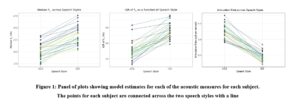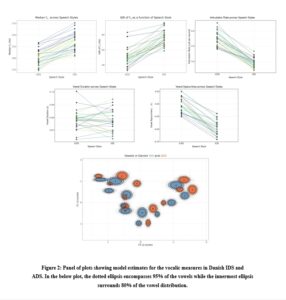Christopher Cox, School of Communication and Culture / Interacting Minds Centre, Aarhus University / Department of Language and Linguistic Science, University of York
Christina Dideriksen, School of Communication and Culture / Interacting Minds Centre, Aarhus University
Tamar Keren-Portnoy, Department of Language and Linguistic Science, University of York
Andreas Roepstorff, School of Communication and Culture / Interacting Minds Centre, Aarhus University
Morten H. Christiansen, School of Communication and Culture / Interacting Minds Centre, Aarhus University / Department of Psychology, Cornell University
Riccardo Fusaroli, School of Communication and Culture / Interacting Minds Centre, Aarhus University
A prominent hypothesis holds that parents may help infants learn language by modifying the acoustic properties of their infant-directed speech (IDS) (Kalashnikova & Burnham, 2018; Kuhl et al., 1997; Liu et al., 2003). The benefits of IDS to phonological development are generally attributed to its tendency to increase the clarity of the speech addressed to children (cf., Kuhl et al., 1997; Liu et al., 2003). For example, IDS has been shown to exhibit a higher degree of separability in its phonetic categories through vowel space expansion, which in turn, has been shown to correlate with language outcomes at a later point in development (Dilley et al., 2020; Hartman et al., 2017; Kalashnikova & Burnham, 2018; Liu et al., 2003).
The current study revolves around Danish, a language characterised by a high degree of phonetic reduction and a wide variety of vocalic sounds (cf., Basbøll, 2005; Trecca et al., 2021). The peculiar sound structure of Danish has led researchers to posit that Danish may be particularly difficult for infants to learn; that is, the sizeable vowel inventory and frequent reduction of obstruents to vocalic sounds in Danish may reduce the availability of processing cues (Bleses et al., 2008a, 2008b, 2011). If the acoustic properties of caregivers’ IDS serve to clarify the linguistic input to Danish-learning infants, we may expect these properties to manifest themselves in a particularly strong manner in Danish (cf., Trecca et al., 2021).
We compare the acoustic properties of 26 Danish caregivers’ spontaneous speech when interacting with their 11-24-month-old infants and an adult experimenter (i.e., adult-directed speech, ADS) on both prosodic and vocalic dimensions. The results indicate that Danish IDS conforms to general cross-linguistic patterns in its prosodic properties, with a higher overall pitch, a greater degree of pitch variability and a slower articulation rate (cf. Figure 1).

The acoustic properties of Danish vowels, however, contradict cross-linguistic tendencies: Danish caregivers produce IDS with similar vowel durations, a reduced or similar vowel space area and a higher degree of within-vowel variability (cf. Figure 2 below).

We argue that these results provide little support for the hypothesis that caregivers help infants learn language by increasing the clarity of their speech. We use these results to reflect on the scientific study of IDS and highlight the need for theory-driven comparisons across a diverse intersection of languages and cultures (Christiansen et al., 2022; Deffner et al., 2021; Kidd & Garcia, 2022).
References
Basbøll, H. (2005). The phonology of Danish. Oxford University Press.
Bleses, D., Basbøll, H., & Vach, W. (2011). Is Danish difficult to acquire? Evidence from Nordic past-tense studies. Language and Cognitive Processes, 26(8), 1193–1231.
Bleses, D., Vach, W., Slott, M., Wehberg, S., Thomsen, P., Madsen, T. O., & Basbøll, H. (2008a). Early vocabulary development in Danish and other languages: A CDI-based comparison. Journal of Child Language, 35(3), 619–650.
Bleses, D., Vach, W., Slott, M., Wehberg, S., Thomsen, P., Madsen, T. O., & Basbøll, H. (2008b). The Danish Communicative Developmental Inventories: Validity and main developmental trends. Journal of Child Language, 35(3), 651–669.
Christiansen, M. H., Kallens, P. C., & Trecca, F. (2022). Towards A Comparative Approach to Language Acquisition. Current Directions in Psychological Science, 1–8. https://doi.org/10.1177/09637214211049229
Deffner, D., Rohrer, J. M., & McElreath, R. (2021). A Causal Framework for Cross-Cultural Generalizability. PsyArxiv.
Dilley, L., Lehet, M., Wieland, E. A., Arjmandi, M. K., Kondaurova, M., Wang, Y., Reed, J., Svirsky, M., Houston, D., & Bergeson, T. (2020). Individual Differences in Mothers’ Spontaneous Infant-Directed Speech Predict Language Attainment in Children With Cochlear Implants. Journal of Speech, Language, and Hearing Research, 63(7), 2453–2467.
Hartman, K. M., Ratner, N. B., & Newman, R. S. (2017). Infant-directed speech (IDS) vowel clarity and child language outcomes. Journal of Child Language, 44(5), 1140–1162.
Kalashnikova, M., & Burnham, D. (2018). Infant-directed speech from seven to nineteen months has similar acoustic properties but different functions. Journal of Child Language, 45(5), 1035–1053.
Kidd, E., & Garcia, R. (2022). How diverse is child language acquisition? First Language, 1–33. https://doi.org/10.1177/01427237211066405
Kuhl, P. K., Andruski, J. E., Chistovich, I. A., Chistovich, L. A., Kozhevnikova, E. V., Ryskina, V. L., Stolyarova, E. I., Sundberg, U., & Lacerda, F. (1997). Cross-language analysis of phonetic units in language addressed to infants. Science, 277(5326), 684–686.
Liu, H., Kuhl, P. K., & Tsao, F. (2003). An association between mothers’ speech clarity and infants’ speech discrimination skills. Developmental Science, 6(3), F1–F10.
Trecca, F., Tylén, K., Højen, A., & Christiansen, M. H. (2021). Danish as a Window Onto Language Processing and Learning. Language Learning, 71, 799–833.


